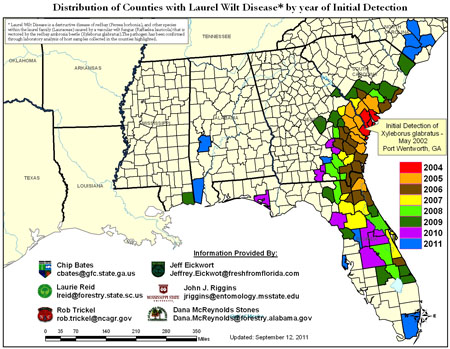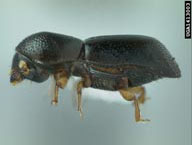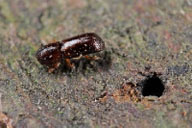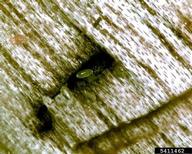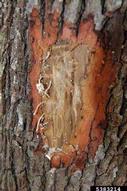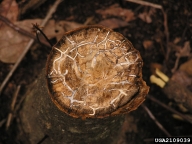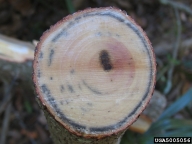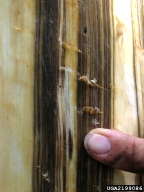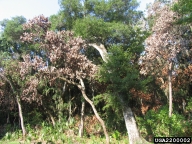Redbay ambrosia beetle
Xyleborus glabratus Eichhoff (Coleoptera: Curculionidae, Scolytinae)
Orientation to pest
The redbay ambrosia beetle, Xyleborus glabratus Eichhoff, was detected in the United States for the first time in 2002 and has since caused extensive mortality of redbay (Persea borbonia [L.] Spreng.) and sassafras (Sassafras albidum [Nutt.] Nees) in coastal areas of South Carolina, Georgia, and parts of Florida. This ambrosia beetle is the vector of a lethal fungal pathogen (Raffaelea lauricola Harrington, Fraedrich and Aghayeva) that affects various species in the Lauraceae. Infected trees wilt and die within a few weeks or months of initial infection. This disease has been designated as "laurel wilt," and it is believed to have arrived along with the redbay ambrosia beetle in wood packing material (crates and pallets) used in trade. Xyleborus glabratus is about 2 mm long, dark brown to almost black in color, nearly glabrous (shiny, without hairs), and has an abruptly slanting depression at the tip of it abdomen. However, positive confirmation of this species' presence in a new area requires confirmation by a taxonomic specialist. Very little is known specifically about the biology of this beetle but it is likely similar to that of other members of this genus (see other insects in this CD). Adults and larvae inoculate new galleries with spores of a symbiotic pathogenic fungus, which are carried in special pockets at the base of the beetles' mandibles. Males are flightless. Females can attack healthy hosts, and - in Florida and Georgia - female beetles fly throughout the year although at very low numbers in the winter. Signs of redbay ambrosia beetle attack include small strings of compacted sawdust protruding from the bark at the point of attack, but these strings soon disintegrate and are not unique to this species. Small holes the diameter of a paperclip wire in redbay are usually redbay ambrosia beetle entrance holes. Foliage of infested trees wilts because the fungal infection is systemic in the vascular elements of the tree, and foliage turns reddish brown. As infected trees start to die, they may also be attacked by other species of ambrosia beetle particularly Xylosandrus crassiusculus (Motschulsky). In Florida, up to 90% of redbay trees died in less than two years following initial beetle invasion of a new site. Loss of redbay will likely severely harm populations of the Palamedes swallowtail (Papilio palamedes [Drury]), which feeds primarily on species of Persea. There is also considerable concern about the potential impact of laurel wilt on avocado (Persea americana Miller), which is an economically important crop in Florida and California.
Hosts commonly attacked
In addition to redbay (P. borbonia) and sassafras (S. albidum), the wilt pathogen spread by the redbay ambrosia beetle has been recovered in the United States from avocado (P. americana), swampbay (Persea palustris [Raf.] Sarg.), pondspice (Litsea aestivalis [L.] Fernald), pondberry (Lindera melissifolia [Walter] Blume) and camphor (Cinnamomum camphora [L.] Sieb.). Pondspice and pondberry are of special concern because they are rare or endangered species. Avocado is of concern because of its economic importance.
Distribution
The redbay beetle is native to South Asia (India, Myanmar) and East Asia (Japan, Taiwan). The invaded range in the United States includes coastal and adjacent areas of Georgia, South Carolina, and Florida, as well as parts of North Carolina, one area in Mississippi, and two counties in Alabama.
| Figure 1. Map of the range of redbay ambrosia beetle in the United States |
Images of redbay ambrosia beetle
| Figure 2. Adult of the redbay ambrosia beetle; right, insect in natural position | Figure 3. Egg of redbay ambrosia beetle, inside gallery cut by female beetle | Figure 4. Larva of redbay ambrosia beetle | |
| Figure 5. Ambrosia beetles produce frass tubes at points of entrance for adult beetles during the construction of their galleries. The long tubes are Xyleborus crassiusculus, while the very short tubes in the debarked area are redbay ambrosia beetle. | Figure 6. Galleries of redbay beetle in redbay tree trunk, seen in cross section |
| Figure 7. Dark staining of the vascular tissue is a sign of the fungus associated with the redbay ambrosia beetle | Figure 8. Dead redbay killed by redbay ambrosia beetle and its associated fungus. The percentage of redbay mortality in this section of Florida forest increased from 10% to 81% within a year. |
Important biological control agents related to this pest species
Natural enemies of redbay ambrosia beetle are unknown at this time.
Web links for information on redbay ambrosia beetle
- Pest Alert on FreshFromFlorida.com | FDACS Division of Plant Industry
- Data Sheet | EXFOR Database, USDA Forest Service
- The Problem with Transporting Firewood | DontMoveFirewood.org | The Nature Conservancy
- Article about pest and the avocado industry in Florida | www.redorbit.com
- Species Page on Invasive.org | Center for Invasive Species and Ecosystem Health and USDA APHIS PPQ
- Laurel Wilt, caused by Raffaelea lauricola | Iowa State University
Brief history, images, and links to articles and reports
Articles
- Douce, G. K. and J. Johnson, 2005. Xyleborus glabratus in Georgia's coastal forests. Georgia Forestry Commission Pest Alert, October 31, 2005.
- Hanula, J. L., A. E. Mayfield III, S. W. Fraedrich, and R. J. Rabaglia. 2008. Biology and host associations of redbay ambrosia beetle (Coleoptera: Curculionidae: Scolytinae), exotic vector of laurel wilt killing redbay trees in the southeastern United States. Journal of Economic Entomology 101: 1276-1286.
- Fraedrich, S.W., T. C. Harrington, R. J. Rabaglia, M. D. Ulyshen, A. E. Mayfield, III, J. L. Hanula, J. M. Eickwort, D. R. and Miller. 2008. A fungal symbiont of the redbay ambrosia beetle causes a lethal wilt in redbay and other Lauraceae in the southeastern United States. Plant Disease 92: 215-224 (for pdf of manuscript see http://www.public.iastate.edu/~tcharrin/LaurelWilt.html).
- Harrington, T. C., S. W. Fraedrich, D, N. and Aghayeva. 2008. Raffaelea lauricola, a new ambrosia beetle symbiont and pathogen on the Lauraceae. Mycotaxon 104: 399-404 (see http://www.public.iastate.edu/~tcharrin/LaurelWilt.html).
- Mayfield, A. E, T. C. Harrington, S. Fraedrich, J. Hanula, and others. 2009. Recovery plan for laurel wilt on redbay. In: Plant Diseases that Threaten U.S. Agriculture. Prepared for the National Plant Disease Recovery System, USDA and the American Phytopathological Society. 27 pp. (see http://www.public.iastate.edu/~tcharrin/LaurelWilt.html).
